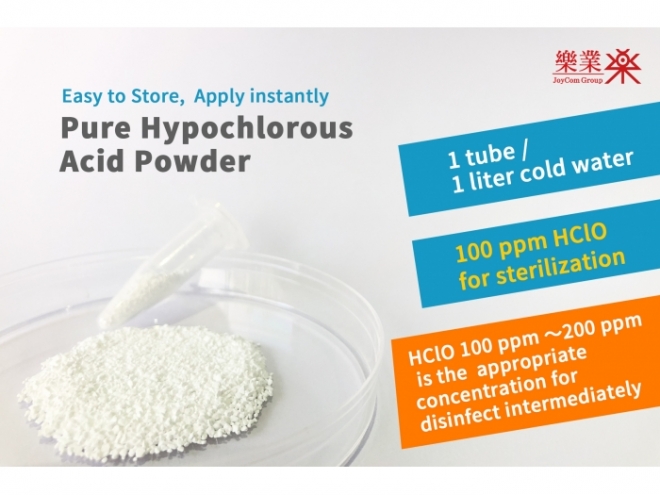.jpg)
JoyCom Group® Pure Hypochlorous Acid Powder (HAP)
- Approved by Taiwan global anti-epidemic pavilion
- Effectively eliminate 99.9% of viruses and bacteria
- Freshly prepared to ensure effective concentration
- Convenient for storage and carrying

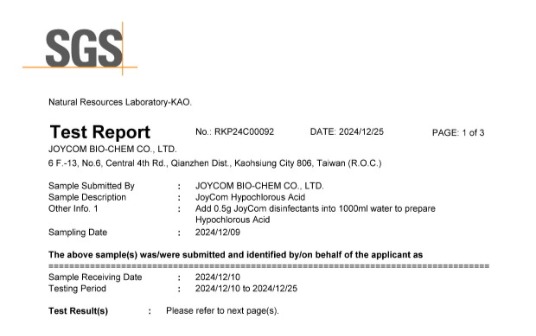
JoyCom Group Hypochlorous Acid Powder is made from pure raw materials, with an initial mixing concentration of up to 300ppm, and can maintain effectiveness for over 3 weeks
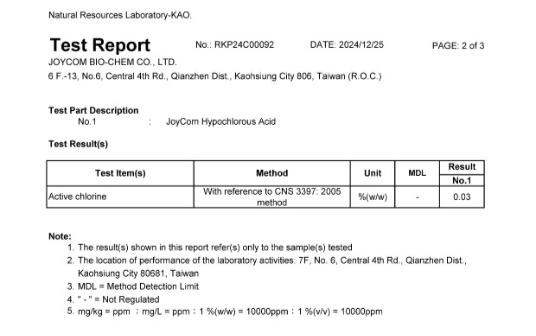
When dissolving 0.5g of Hypochlorous Acid Powder in 1000ml of tap water, it yields an active chlorine concentration of 0.03%

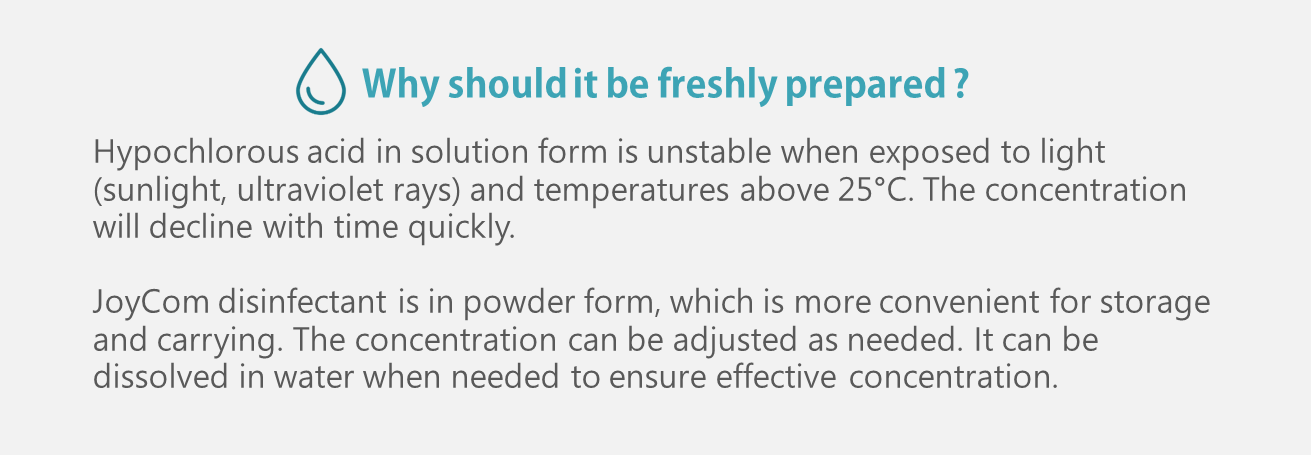
Usage:
Only one step, dissolve 1 pack of JoyCom Disinfectants in 1 liter cool-water
and you will get the fresh 100 ppm HOCls.
Storage:
- Please store in a cool place, avoid sunlight, high temperature, humidity and contacting with metals.
- Please store HOCls in the opaque HDPE or PP container.
- To disinfect exactly, the fresh HOCl solution should be applied in 1 month as soon as possible.
JoyCom Disinfectants v.s. Other disinfection products
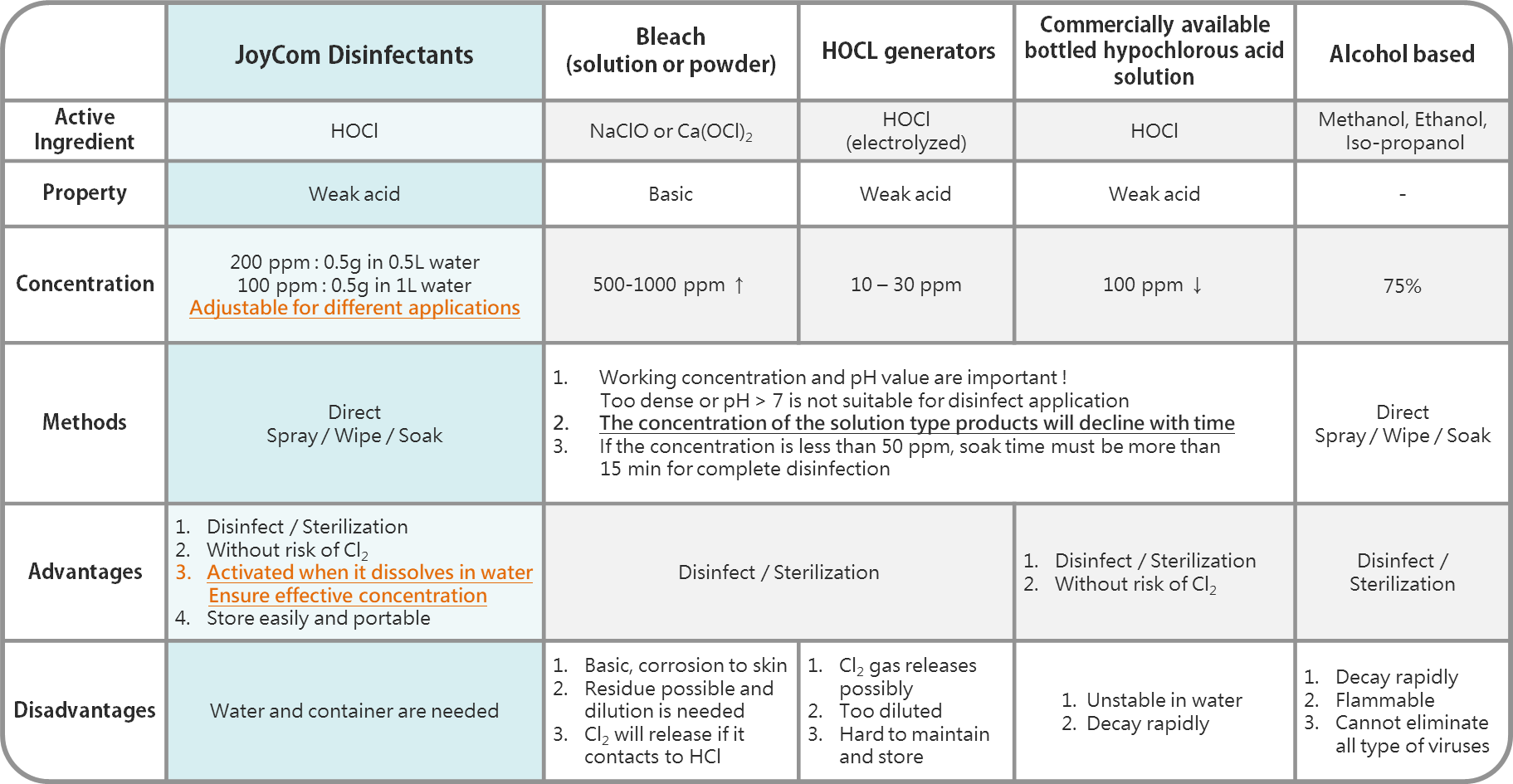
How to prevent COVID-19 in daily life?
You can reduce the risks of being infected or spreading COVID-19 by using disinfectants such as Alcohol , Bleach or Hypochlorous acid. But do you know the differences between Alcohol , Bleach and Hypochlorous acid ?
Bleach, NaClO, Basic pH > 7
Avoid skin contact due to its irritation.
Smelly chlorine odor.
Hyprochlorous acid solution (HOCls), weak acid pH < 7
HOCls has excellent disinfectant effect for anti-virus and antibacterial. It is better than Alcohol-based products, and has less damages to skin because Hyprochlorous Acid (HOCl) is also self-produced in our body. Many researches show that HOCls has therapy potentials on wound clean, anti-pruritus (itch), deodorant and disinfectant on surgery or chronic wound.
.jpg)
Althourgh HOCls is so powerful, when you apply it, you must obey the following advice.
- Attention! HOCls ≠ NaClO ( Bleach)
- Proper working concentration : 100 ~ 200 ppm for instant disinfect (within 1 min)
- Avoid storing the HOCls made by electrolyzed because of the risk of toxic chlorine gas regeneration.
- Correct pH value! Improper condition (pH >7) is not only invalid on disinfect but also harmful for human.
References:
- Hypochlorous Acid as a Potential Wound Care Agent., JOURNAL OF BURNS AND WOUNDS, 2007
- Hypochlorous Acid: An Ideal Wound Care Agent With Powerful Microbicidal, Antibiofilm, and Wound Healing Potency, WOUNDS, 2014; 26(12):342-350.
- Topical stabilized hypochlorous acid: The future gold standard for wound care and scar management in dermatologic and plastic surgery procedures. J Cosmet Dermatol. 2020;00:1–8.
- Topical Hypochlorous Acid (HOCl) as a Potential Treatment of Pruritus. Curr Derm Rep, (2013) 2:181–190.
- Evaluation of sprayed hypochlorous acid solutions for their virucidal activity against avian influenza virus through in vitro experiments. J. Vet. Med. Sci. 77(2): 211–215, 2015.
- 0.01% Hypochlorous Acid as an Alternative Skin Antiseptic: An In Vitro Comparison., Dermatol Surg, 2018; 44:1489–1493.
- Hypochlorous acid gel technology—Its impact on postprocedure treatment and scar prevention. J Cosmet Dermatol. 2017; 1–6.
- Hypochlorous acid is anti-pruritic and anti-inflammatory in a mouse model of atopic dermatitis. Clin exp allergy, Jan;48(1):78-88.


